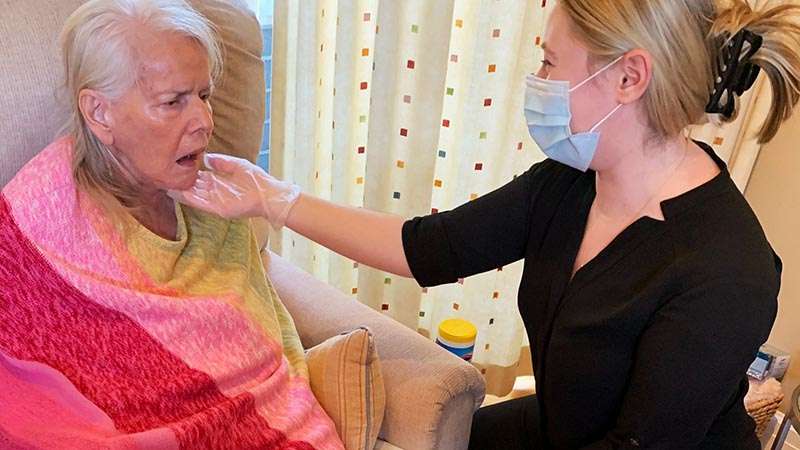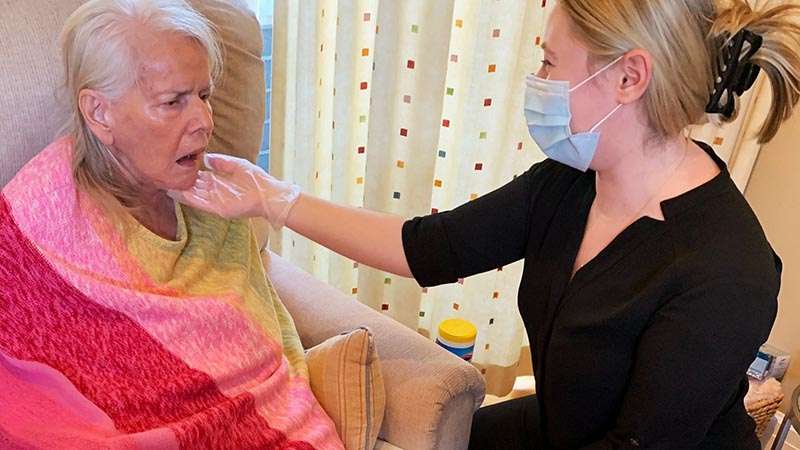An occupational therapist’s job is to restore a person’s ability to perform daily tasks as independently as possible. These tasks include basic activities of daily living and instrumental activities of daily living (ADLs).
[current_date]
Basic ADLs include eating, dressing, using the restroom, and bathing. Instrumental activities of daily living include driving, meal preparation, and volunteering. When one experiences difficulty with basic or instrumental ADLs, occupational therapy can support the return to independent function with the following six benefits!

1. Improve Range of Motion & Strength Safely
Surgery, arthritis, or a stroke can create changes in the amount of available movement in joints such as the shoulder joint. Occupational therapists work with their clients to improve range of motion through:
Passive range of motion, where therapists stimulate the performance of motion for their client assisting them in making small joint-related movement, called active assistive range of motion.
Active range of motion is when a patient moves their arm or performs other joint-related movements on their own, without physical assistance.
Proper body positioning, such as lying down on the back or side also supports the return of independent function with full range of motion. In a lying position, resistance caused by gravity is decreased, while increasing the ease of joint mobility. Pain can easily occur if a person pushes themselves too hard and/or too fast while being positioned poorly.
Compensatory prevention techniques are strategies designed to bypass loss of strength in order to allow for some movement, while building strength. A common compensatory technique that people with a weak shoulder joint may use, as an example, is to shrug the shoulder upward and bring the arm close to the body. Although this can allow for some motion, over time it will actually create pain and further decrease strength.
2. Decrease Pain, While Building Strength
Newton’s 3rd Law of Motion, a widely taught theory and physics lesson, states that for every action, there is an equal and opposite reaction, which applies to the movements of the human body. For example, when one muscle is weak, the opposite muscle might become too tight, causing pain. Compensatory techniques, such as hiking the shoulder to keep the arm close to the body in an effort to reduce pain, often causes muscle imbalance, and consequently, increased pain. With compensatory techniques, involving shoulder movement, the muscle at the chest (called the pectoralis major) often begin to tighten causing the muscles around the shoulder blade to become weak.
Occupational therapy exercises can help.
With the benefits of occupational therapy, patients become educated and more aware of how improper body positioning contributes to the risk of increased pain. Stretching techniques and manual guided exercises provided by occupational therapists are designed to improve weak joint movement and reduce pain, while improving the use of an extremity for ADLs.
3. Get Adaptive Strategies & Equipment
Needing the help of another person to perform daily activities is not ideal. The ultimate job of an occupational therapist is to improve a person’s ability to independently perform activities of daily living. With the help of an experienced occupational therapist, participants will see improved range of motion and, in most cases, naturally be able to perform important daily tasks again due to the positive effects resulting from key benefits of occupational therapy.
In some cases with severe limitations in range of motion, more aggressive adaptive strategies or adaptive equipment may be required:
- Adaptive strategies refer to any techniques or efforts aimed at helping someone adapt to their current ability to engage in an ADLs:
Energy conservation refers to adaptive efforts taken to combat excessive fatigue and conserve energy for the activities that are most important. Energy conservation is particularly helpful for people with significant cardiac disease who easily fatigue when performing daily living activities.As an example, drying off after bathing is a necessary activity, but using a towel to do so can be exhausting. An occupational therapist can teach energy conservation strategies and provide more suitable options when adapting ADL limitations, such as wearing a Terry-Cloth robe to allow for air-drying after a bath or shower.
- Adaptive equipment refers to any device used to assist in performing ADL tasks with greater ease and comfort levels:
Jar openers and shower chairs are considered adaptive equipment. A jar opener increases the amount of torque a person can apply to open their favorite jar of salsa. Shower chairs can allow a person with limited balance to sit and bathe independently vs. attempting to stand to bathe and risk falling.
4. Improve Visual Skills
Changes in vision can occur with eye disease and after a brain injury or a stroke. These changes create blind spots in our field of vision. Visual changes can affect a person’s ability to walk confidently or read. Occupational therapy can teach visual adaptive techniques such as scanning and pre-reading strategies to improve performance and overall experience when reading.
5. Home Safety Assessments
Occupational therapists love nothing more than supporting a person’s ability to remain in their own home when confronting a disability or grow in age. A key benefit of occupational therapy is the peace-of-mind gained from a home assessment conducted by an experienced and trained occupational therapist. These assessments address safety in the home including evaluating the amount of clutter obstructing walkways and other living spaces, the amount of adequate lighting, and assessing the need adaptive equipment.
6. Caregiver Training
It can feel horrible and heartbreaking when watch a loved one suffer through the process of performing daily living tasks. It’s even more difficult to be a caregiver experiencing personal guilty and/or frustrations with a family member experiencing challenges with ADLs. Part of an occupational therapists’ role is to train caregivers and help them to better understand the seen and unseen part of a disease, including the resulting limitations and disabilities. A good example of this would be explaining the cognitive changes that occur in people with Parkinson’s Disease, including visual hallucinations and decreased memory.
For more on caregiver training and education, check out our recent blog post, “Stroke Caregivers, This Blog Is for YOU.†While there are many events that cause ADL challenges and limitations outside of a stroke, such as diagnosis of dementia or Parkinson’s disease, caregiver support and education is a valuable benefit of occupational therapy and a vital component of the successful return to independent function.
